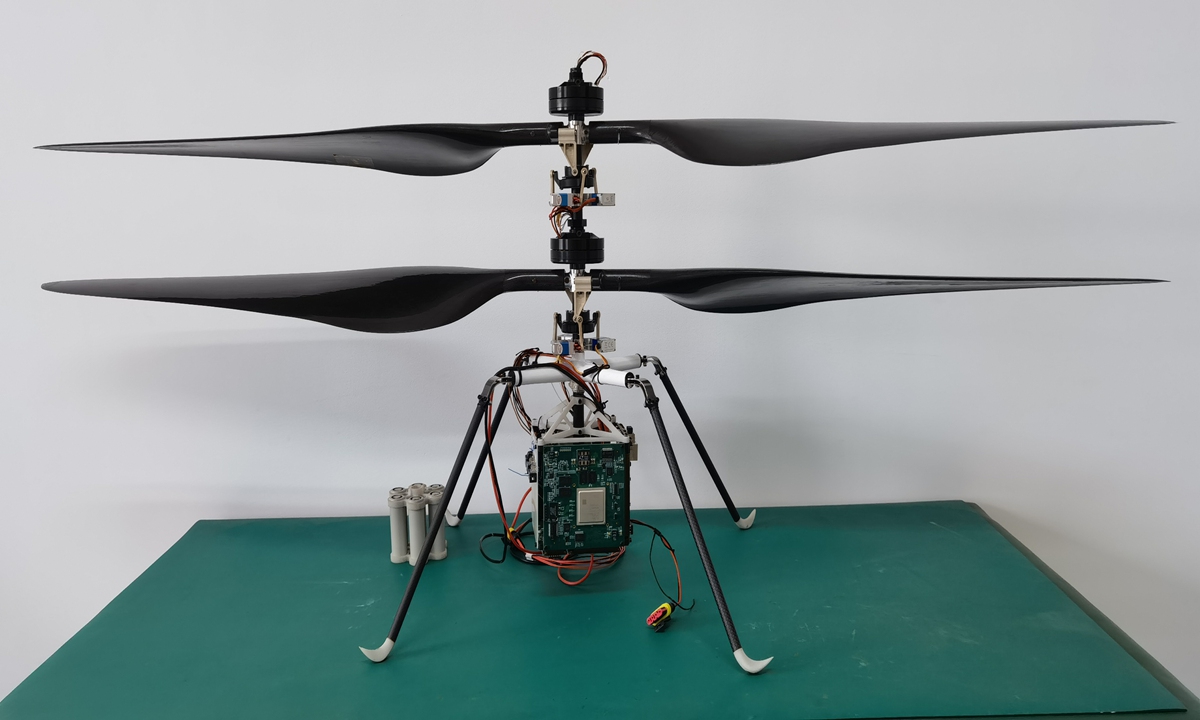
The prototype of the Mars cruise drone Photo: Courtesy of NSSC, CAS
The newly developed and recently unveiled prototype miniature helicopter drone, a possible means to support China's Mars missions, is designed to become a navigator for the Mars rover. It will greatly boost the latter's ability to explore valuable targets on the surface of the Red Planet, the project leader said on Monday.
Carrying a small-sized multispectral detection and imaging system, the "Mars surface cruise drone system" is capable of forming image of a large area of within a radius of a few hundred meters in a single flight, which enables the rover to rapidly grasp the surrounding terrain for a safer and faster drive via precision guiding, Bian Chunjiang, a researcher with the National Space Science Center (NSSC) under the Chinese Academy of Science and chief scientist of the project, told the Global Times in an exclusive interview on Monday.
Also, the system's quick imaging and analysis of the landscape and surface composition features would help the rover to fast locate and drive toward targets with high precision, enhancing the mission's efficiency, Bian note.
According to the NSSC, researchers are mulling to adopt solar energy or a wireless electricity-charging method to supply power for the Mars drone system, or a mixture of both.
The concept of flying a craft on Mars has recently been verified by NASA. The Perseverance rover landed on Mars in February, carrying with it the 1.8-kilogram Ingenuity Mars Helicopter.
The vehicle made the first powered flight by an aircraft on another planet in April and conducted its 13th and most recent flight on Sunday.
Bian noted that two blades with a common axis is the best technological path to date, surpassing other methods to support a vertical take-off and vertical landing capability on Mars surface.
Currently, NSSC researchers are still working toward breakthroughs in key technological barriers for the Mars surface cruise system, and verifying its feasibility to lay grounds for future Mars surface surveillance missions.
The technology has been proven practical through the prototype development and environmental simulation tests, Bian said.
The follow-up will focus on the long-term survival in a complex environment like the surface of Mars, and carry out related technical research and verification work, according to Bian.
It is very challenging to take off from and land on the surface of Mars, where the atmosphere is very thin. The atmospheric pressure is only 0.7 to 0.8 percent of that on the Earth's surface, or equivalent to the pressure at an altitude of 30,000 to 40,000 meters above the Earth's surface. The drone will also have to operate in extremely low temperatures and deal with the difficulty of autonomous charging on Mars, Bian said.
On September 1, the NSSC unveiled the Mars drone system, which passed tests by the Beijing Science and Technology Committee earlier in August.
The news came following the remarkable victory by the country's first interplanetary mission Tianwen-1 that pulled off orbiting, landing and roving the Red Planet all in one go, a first in humanity history.
Zhang Kejian, administrator of the China National Space Administration (CNSA), told the media on Friday that such feats position China as one of the leading players in the field of interplanetary exploration.
China plans to launch a Mars sample-return mission and a Jovian system exploration mission sometime about 2030, a CNSA official said in June, the Xinhua News Agency reported.




